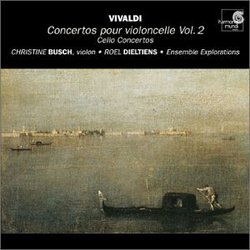| All Artists: Antonio Vivaldi Title: Vivaldi: Cello Concertos, Vol. 2 Members Wishing: 0 Total Copies: 0 Label: Harmonia Mundi Fr. Release Date: 4/9/2002 Album Type: Import Genre: Classical Styles: Chamber Music, Forms & Genres, Concertos, Historical Periods, Baroque (c.1600-1750), Classical (c.1770-1830), Instruments, Strings Number of Discs: 1 SwapaCD Credits: 1 UPC: 794881669721 |
Search - Antonio Vivaldi :: Vivaldi: Cello Concertos, Vol. 2
CD Details |
CD ReviewsBest Recording of Vivaldi Cello Cencerti Andrew Judkins | 10/18/2008 (5 out of 5 stars) "This CD is the best presentation of Vivaldi cello concerti out there. Roel Dieltiens exudes great personality and imagination in his playing. I consider him the cello equivalent of Guliano Carmignola (violin) as far as being in tune with Vivaldi's music. Ensemble Explorations is a perfect complement-spontaneous, passionate and visceral. They have me hooked on the one per part sound. The one part that is not single player is the bass line, which is conceived with a large combination of instruments: cello, harpsichord, guitar, organ, theorbo, bass. It's not that this list is so unusually large for period-instrument groups, but the way they are used to enliven the vision of the music is outstanding. For example-the accompaniment for the slow movement of RV 408, which can only be described as harrowing, is double bass and organ. The organ opens the movement with a `cadenza' of blending chords, an addition that might seem presumptuous at first listening, but will grow on you.
The program consists of some odd, lesser-known Vivaldi cello works, which in other's hands might seem not to be Vivaldi's best efforts. The early concerto in A minor RV 420 may have been written before 1710. Despite this, it explodes with imagination. The opening andante is a cantabile movement miles ahead of its time, a perfect exploitation of the cello's sound. The angular and singing alternations of the slow movement are very clever in conception and details. The last movement is a classic ritornello fast movement with furious material. The later concerto in E flat major RV 408 has a clever, strutting opening and a rustic dance for a close. In between is a harrowing slow movement of such weight that the bottom almost falls out of the composition. The short F major concerto RV 411 is pastoral, like a breath of fresh country air. This is a piece of joy, lacking all pretension. The concerto in D minor RV 407, is also one of Vivaldi's earliest concertos. It has a robust war-like opening with strange droning and other rustic tinges. The ostinato slow movement has the cello inventing beautiful melodies over a chromatic line, played by the unison orchestra. The last movement is a fun-loving gigue that feels like an earthy homage to mother nature. The double concerto for violin and cello "Il Proteo o sia Il mondo al rovescio" RV 544 is beautiful and fun-loving despite its joke-like concept (the two solo parts are interchangeable-- written in the each soloist's clef but written down or up and octave). The opening melody is cocky and rhythmically spirited. The slow movement is a beautiful dialogue between soloists, recalling masculine and feminine. The last movement features a robust, forceful tune with rapid exchanges between soloists. The performers are at the top of their game here. The concerto in A minor RV 421 is spirited and lonely like a mountain landscape. The violins have clever interactions in the first movement, with a cantabile touch to the solo writing. This work contains one of Vivaldi's vintage `molto prepetuo' passages. Last is the odd concerto in C for violin and two cellos. The writing is mostly like a double concerto, with a conversation between the violin and a tandem of cellos. This work is from the period is from the period 1718-1723, a time when Vivaldi was composing works such as the Four Seasons. The texture may leave you flat, but the brio of the writing is top notch. If Roel Dieltiens and Ensemble Explorations are listening: Record more of these works!" |

